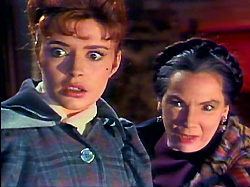|
||
|
The story finds a young French schoolteacher, Marianne (Yvonne Monlaur) traveling alone to her new post at a girl's academy in Badstein. Along the way, a mysterious stranger bribes her frightened, guilty-looking coachman to abandon her at a small town. The innkeeper and his wife, who must rank as the friendliest bunch of fear-crazed locals in the Hammer Dracula canon, do their best to hustle her out of town, but stop short of telling her that the elderly Baroness Meinster (Martita Hunt) who befriends her has been the death of many a young woman traveler. All unsuspecting, our heroine goes with the Baroness to spend the night at her castle, and finds a young man—the Baron Meinster—thought by the locals to be dead, who is being kept captive with a chain around his ankle. Taken in by his blond good looks and evident charm, the young lady engineers his escape, thus unleashing him on the countryside to resume the fiendish depravities of the Undead. The first sign that Marianne might have made a mistake is the long hysterical cackling of family servant Greta (Freda Jackson), as she kneels by the unlocked chains that held the Baron until recently. Greta later acts as a sort of deranged cheerleader for the new vampires in the story. Luckily for the locals, their curé has already sent for the assistance of Doctor Van Helsing of Leyden University, where he is Doctor of Philosophy, Doctor of Theology, and Professor of Metaphysics. So eminent an expert easily understands what the buffoonish local medical man does not, that the local superstition about vampires is well founded, and the twin cuts on the neck of a newly departed local girl show that she has become the latest victim of the fiendish plague. A curiousity is that in one shot, Van Helsing's medical bag can clearly be seen to bear the initials JVH, which would seem to indicate that his first name begins with "J" rather than being Abraham as in Stoker's original story. However, the bag is so old and beat-up looking, it could have belonged to his father. It also includes some implements that might make a patient nervous: a mallet and several wooden stakes, neatly wrapped in chamois. Virtues and Vices The weak points of the movie include the Baron Meinster character, who is not drawn very vividly. David Peel was not given much to work with in the role, but he also simply looks ridiculous whenever he bares his fangs. Another weakness is the laughably thick white makeup slathered on the faces of the vampire "brides," which looks all the more incongruous since the rest of their skin has its natural color. A "comic relief" doctor character also does little to advance the story. Setting Vampire Lore The curé asks: "How can they be destroyed?" Van Helsing: "By driving a wooden stake through the heart, or by burning. The tormented soul is then released to return to the peace of death. These colonies such as you have here must be wiped out. Only then will this bondage of Hell be lifted from the world." "Are there ways of telling these undead from the living?" "They are repelled by holy things and Christian images. They are thin, they have an air of hunger about them, they cast no reflection." "Not in water? Not in a mirror?" "No. Some have the power to transform themselves into bats." This lecture shows that Van Helsing's views have changed somewhat since the first movie, when he denied that vampires can transform into bats or wolves. Also, this may be the only Hammer vampire movie where the vampires cast no reflections. For example, in Dracula Has Risen From the Grave, Dracula's reflection appears in water. In Vampire Lovers, Mircalla is shown brushing her hair in a mirror. Interestingly, although the two young women who arise as vampires show an instant, voluptuous glee and desire to attack others, the old Baroness hides her fangs in distress and willingly remains with Van Helsing until dawn so he can put her out of her misery. Apparently the vampiric mindset doesn't "take" equally well with all victims. What is more peculiar is that while the baroness was relatively depraved in life, given to abducting victims for her Undead son, at least one of the young vampiresses was a relatively sympathetic person in life. Perhaps the evil that has been most thoroughly repressed, bursts forth the more strongly after the vampiric conversion? The power of garlic in this story seems more doubtful. Although Van Helsing shows approval when he sees that the village girl was buried with a garland of garlic flowers, she seems totally unbothered by them when she rises up from the grave. Still, Greta solicitously lifts the flowers off her. Baron Meinster seems to lack the usual super-strength attributed to nosferatu, as in his fight with Van Helsing they seem relatively evenly matched. Unlike most of the rest of the Hammer series, the vampires in this one do show the ablity to transmute into bats for purposes of escape, attack, or just easy travel. More surprisingly, they seem to be able to dematerialize solid objects. Thus, the padlocks fall off of vampire Gina's coffin without ever being unlocked. Similarly, the village girl vampire sticks her hand up out of the earth, even though her coffin lid was still closed at the time. (The latter example is probably just a continuity error, but the former was certainly deliberate.) The highlight of the movie is a scene where Van Helsing, having been bitten by the evil Baron and left for Undead, sterilizes the wound with a hot iron and holy water. Now, that takes nerves of steel! Baron's Demise - Spoiler Loose Ends Sequels Brides of Dracula: Click here for pricing and ordering information. |
||
|
Return to Contents Page for Baharna Books Background pattern from Owen Jones, The Grammar of Ornament Send comments to jfm.baharna@gmail.com |












